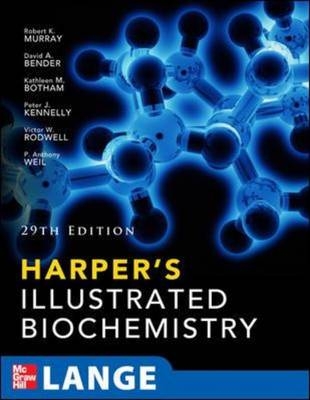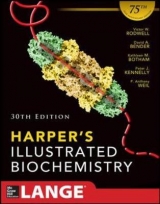
Harpers Illustrated Biochemistry
McGraw-Hill Medical (Verlag)
978-0-07-176576-3 (ISBN)
- Titel erscheint in neuer Auflage
- Artikel merken
Includes 16 case histories
Clear, concise, and in full color, Harper’s Illustrated Biochemistry is unrivaled in its ability to clarify the link between biochemistry and the molecular basis of disease. Combining outstanding full-color illustrations with integrated coverage of biochemical diseases and clinical information, Harper’s offers an organization and careful balance of detail and brevity not found in any other text on the subject.
Following two introductory chapters, the text is divided into six main sections:
Section I addresses the structures and functions of proteins and enzymes.
Section II explains how various cellular reactions utilize or release energy and traces the pathways by which carbohydrates and lipids are synthesized and degraded.
Section III covers the amino acids, their metabolic fates, certain features of protein catabolism, and the biochemistry of the porphyrins and bile pigments.
Section IV describes the structure and function of nucleotides and nucleic acids, DNA replication and repair, RNA synthesis and modification, protein synthesis, the principles of recombinant DNA technology, and new understanding of how gene expression is regulated. Section V deals with aspects of extracellular and intracellular communication.
Section VI includes fifteen special topics, ranging from nutrition, digestion and absorption to the biochemistry of aging
New to this edition:
New chapters on Aging, Cancer, and Clinical ChemistryEvery chapter has been updated to reflect the latest advances in knowledge and technologyEach chapter now begins with a statement of objectives, followed by a brief discussion of the biomedical importance of topics discussed within the chapter250 multiple-choice questions to test your knowledge and comprehensionIncreased number of tables that encapsulate important information, such as vitamin and mineral requirements
McGraw-Hill authors represent the leading experts in their fields and are dedicated to improving the lives, careers, and interests of readers worldwide Robert K. Murray, MD, PhD Professor (Emeritus) of Biochemistry University of Toronto Toronto, Ontario Daryl K. Granner, MD Joe C. Davis Professor of Biomedical Science Director, Vanderbilt Diabetes Center Professor of Molecular Physiology and Biophysics and of Medicine Vanderbilt University Nashville, Tennessee Peter A. Mayes, PhD, DSc Emeritus Professor of Veterinary Biochemistry Royal Veterinary College University of London London Victor W. Rodwell, PhD Professor of Biochemistry Purdue University West Lafayette, Indiana
Section 1: Structures and Functions of Proteins and Enzymes
1. Biochemistry & Medicine
2. Water & pH 7
3. Amino Acids & Peptides
4. Proteins:Determination of Primary Structure
5. Proteins: Higher Orders of Structure
6. Proteins: Myoglobin & hemoglobin
7. Enzymes:Mechanism of Action
8. Emzymes: Kinetics
9. Enzumes: regulation of Activities
10. Bioinformatics & Computational Biology
Section 2: Bioenergetics and the Metabolism of Carbohydrates and Lipids
11. Bioenergetics: The Role of ATP
12. Biologic Oxidation
14. Carbohydrates of Physiologic Significance
15. Lipds of Physiologic Significance
16. Overview of Metabolism & the Provision of Metabolic Fuels
17. The Citric Acid Cycle: The Catabolism of Acetyl-CoA
18. Glycolysis & the Oxidation of Pyruvate
19. Metabolism of Glycogen
20. Gluconeogenesis & the Control of Blood Glucose
21. The Pentose Phosphate Pathway & Other Pathways of Hexose Metabolism
22. Oxidation of Fatty Acids: Ketogenesis
23. Biosynthesis of Fatty Acids & Eicosanoids
24. Metabolism of Acylglycerols & Sphingolipids
25. Lipid Transport & Storage
26. Cholesterol Synthesis, Transport, & Excretion
Section 3: Metabolism of Proteins and Amino Acids
27. Biosynthesis of the Nutritionally Nonessential Amino Acids
28. Catabolism of Proteins & of Amino Acid Nitrogen
29. Catabolism of te Carbon Skeletons of Amino Acids
30. Conversion of Amino Acids to Speicalized Products
31. Pophyrins & Bile Pigments
Section 4: Structure, Function and Replication of Infomraitonal Macromolecules
32. Nucleotides
33. Metabolism of Purine & Pyrimidine Nucleotides
34. Nucleic Acid Structure & Function
35. DNA Organization, Replication, & Repair
36. RNA Synthesis, Processing, & Modification
37. Protein Synthesis & The Genetic Code
38. Regulation of Gene Expression
39. Molecular Genetics, Recombinant DNA, & Genomic Technology
Section 5: Biochemistry of Extracellular and Intracullular Communication
40. Membranes: Structure & Function
41. The diversity of the Endocrine System
42. Hormone Action & Signal Transduction
Section 6: Special Topics (will highlight the 16 cases)
43. Nuturition, Digestion & Absorption
44. Micronutrients: Vitamins & Minerals
45. Free Radicals and Antioxidant Nutrients
46. Intracellular Traffic & Sorting of Proteins
47. Glycoproteins
48. The Extracellular Matrix
49. Muscle & the Cytoskeleton
50. Plasma Proteins & Immunoglobulins
51. Hemostasis & Thrombosis
52. Red & White Blood Cells
53. Metabolism of Xenobiotics
54. The Biochemistry of Aging
55. Cancer: An Overview
56. Clinical Biochemistry
57. Biochemical Case Histories
Appendix
The Answer Bank
Index
| Reihe/Serie | LANGE Basic Science |
|---|---|
| Zusatzinfo | 500 Illustrations, unspecified |
| Verlagsort | New York |
| Sprache | englisch |
| Maße | 221 x 272 mm |
| Gewicht | 1608 g |
| Themenwelt | Medizin / Pharmazie ► Studium ► 1. Studienabschnitt (Vorklinik) |
| Naturwissenschaften ► Biologie ► Biochemie | |
| ISBN-10 | 0-07-176576-X / 007176576X |
| ISBN-13 | 978-0-07-176576-3 / 9780071765763 |
| Zustand | Neuware |
| Haben Sie eine Frage zum Produkt? |
aus dem Bereich



